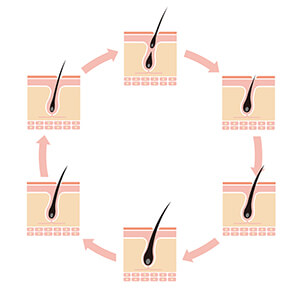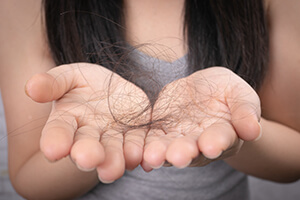We know that life is a constant cycle. Seasons, nature, birth, death and yes, even hair growth follows a cycle. The special thing about the hair cycle is that it has an immediate effect on the length and thickness of your hair. It also affects the amount of hair you will keep on your head after a certain age.
Many of us don't know that there are five different phases of hair growth. Indeed, the hair cycle is a fluid dynamic process. Today, we are going to look at this cycle and its different phases to better understand them. We will then use this information to achieve optimal hair health.
Let's go !

Here is the development phase of our hair and therefore the phase that everyone loves the most! During this phase, the hair strands are still connected to the blood supply and receive nutrients. This phase, which lasts between 2 and 7 years, affects approximately 85% of our hair at any given time.
The anagen phase itself is also divided into 6 stages. During these stages, we see the formation of the hair bulb and follicle, as well as the cells that give our hair its final color (melanocytes).
Melanocytes are of two types: eumelanin and pheomelanin. Eumelanin is responsible for black and brown pigment and pheomelanin for yellow and red pigment. Whatever the color of your hair, these two pigments are found on your head. The proportion of each of the pigments will determine the final color of your hair.
The final stage of the anagen phase begins as soon as the hair emerges on the surface of the skin. This period of growth is said to be genetically predetermined. This explains why some women see their hair grow to the waist while others see their length stop below their shoulders. Keep in mind that if unhealthy hair habits are causing your hair to continue to fall out, you may never have seen the full anagen phase manifest when it comes to hair growth on your head.
Have you ever noticed a long lock of hair on your pillow with a small white spike at the end? This keratinized bulb began to develop during the catagen phase. The catagen phase is a transitional phase. At this point, there is no more hair growth and the anchor that encapsulates your hair strand in its follicle begins to fall apart. This means that your hair is slowly getting ready to detach from your hair follicle.
This stage lasts about 3 weeks and is characterized by the hardening of the hair bulb which is then pushed towards the surface. I know what you're thinking: "7 long years of hair growth only to lose it 3 weeks later?" Well, not quite… At this point, your hair is no longer growing, but hasn't left your head yet. In fact, after so many years of growth, your hair follicles need a little rest! This rest will take place in the next phase, called the telogen phase.
The telogen phase is a resting phase that lasts about 3 to 4 months. Hair in this phase no longer receives nutrients, so it tends to become dull and more prone to breakage. At any given time, approximately 15% of your hair is in the telogen phase. Since we have on average 150,000 hair follicles on our heads, it is not alarming to lose up to 100 hairs a day.
The phase in which the hair actually leaves the scalp, the shedding phase, is called the exogenous phase and lasts about 1-3 days. The hair you find during this phase has a hardened follicle attached to the opposite end.
The last phase is called the kenogenic phase and consists of a dormant phase during which the hair follicle is empty and no activity takes place. This phase usually persists between 1 to 5 months. It may be longer in case of genetic hair loss. Needless to say, we don't want our hair follicles to stay in this phase for too long.
After kenogenesis, our hair follicles descend towards the root (papilla) and the complete hair cycle begins again! Each hair cycle is an opportunity for your hair to improve, stay stable or, in some cases, deteriorate. You will have between 25 and 30 cycles throughout your life.

- When you find a loose hair, determine if it is a hair that has a white bulb at the opposite end. If the answer is yes, that hair has gone through a full growth phase and that can give you an idea of your potential hair length. Keep in mind that not all of your hair will grow in the same amount of time. It is still a good starting point to observe.
- If you notice that the hair you find is mostly broken (without a bulb), ask yourself why? Too many manipulations? Wrong choice of products? A bad diet? Hair dyes? There are many factors to think about. Knowing that your hair is breaking before it reaches its full growth potential should give you the motivation to deal with it better and allow it to flourish.
- Visually track your hair loss. Now that you know your hair shouldn't fall more than 100 hairs a day, notice how much hair you find in the shower, on your pillow, and in your hairbrush. Be aware that before the hair loss is severe enough to reveal your scalp, you will have lost approximately 80% of your hair. At that point, the situation will have gotten out of hand. By keeping an eye on your hair loss, you can notice any abnormalities before it's too late.
- If after 6 months your hair does not grow back, seek professional help. Start with your doctor and also consult a trichologist who specializes in hair and scalp disorders.
I really hope this article was helpful and informative. If you have any questions, please comment them below!



